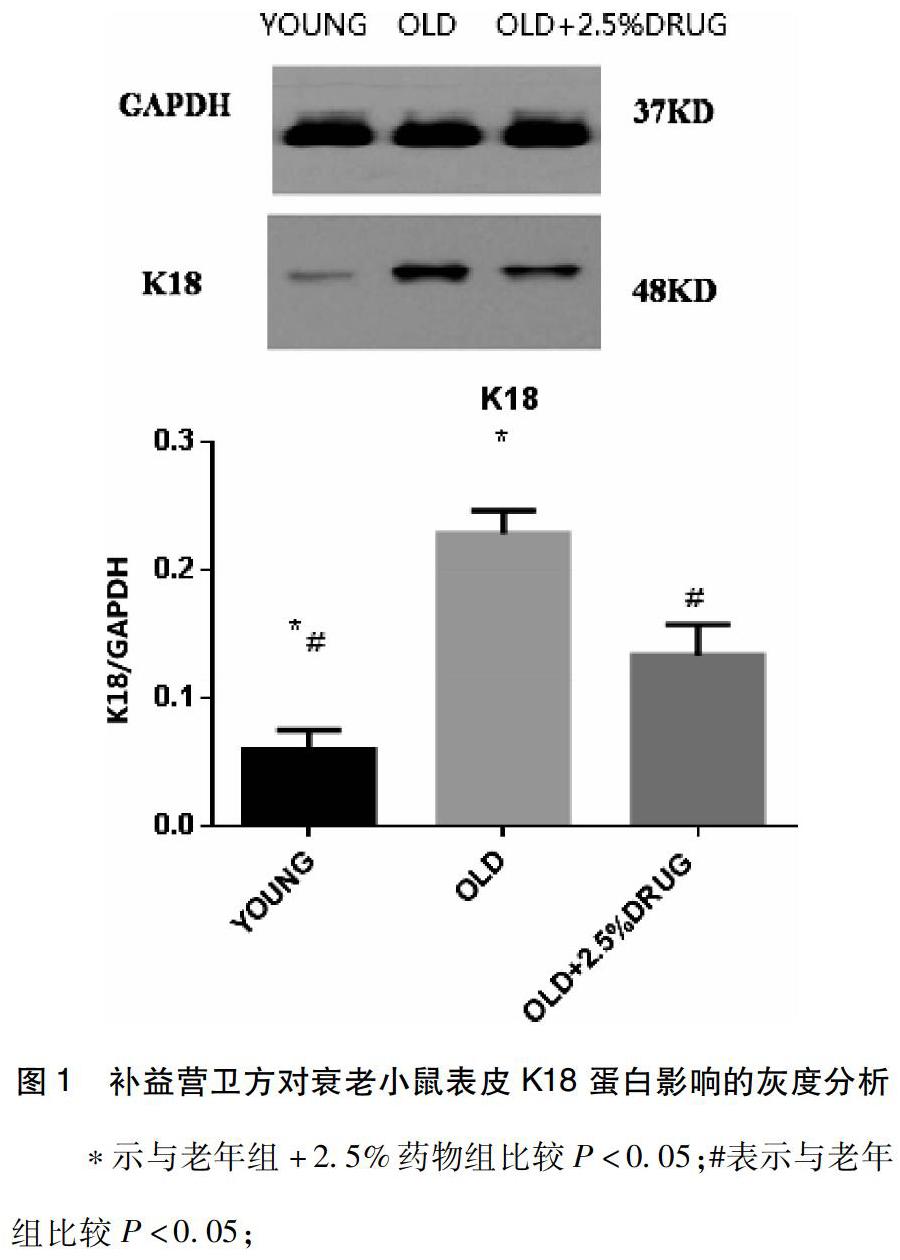補(bǔ)益營衛(wèi)方對衰老皮膚表皮角蛋白18的影響
王浩 周小平


摘要:目的 觀察補(bǔ)益營衛(wèi)方對衰老小鼠表皮角蛋白(Keratin,K)18的影響,探討補(bǔ)益營衛(wèi)方延緩皮膚衰老的機(jī)制。方法 傳代培養(yǎng)年輕小鼠與自然衰老小鼠表皮細(xì)胞,將衰老小鼠表皮細(xì)胞分為2組,一組常規(guī)培養(yǎng),一組用含2.5%補(bǔ)益營衛(wèi)方培養(yǎng)基培養(yǎng)。采用蛋白免疫印跡法(Western blot)及實(shí)時(shí)熒光定量聚合酶鏈?zhǔn)椒磻?yīng)(Real-time PCR)分別檢測細(xì)胞K18蛋白、mRNA表達(dá)水平。結(jié)果 與年輕組比較,老年組K18蛋白與mRNA表達(dá)水平顯著升高(P<0.05);經(jīng)2.5%藥物干預(yù)后衰老表皮細(xì)胞中K18蛋白與mRNA表達(dá)水平較老年組降低(P<0.05)。結(jié)論 補(bǔ)益營衛(wèi)方通過抑制衰老皮膚表皮K18蛋白及mRNA表達(dá)而延緩皮膚衰老。
關(guān)鍵詞:營衛(wèi);皮膚衰老;角蛋白18;中醫(yī)藥
中圖分類號(hào):R285.5 ? 文獻(xiàn)標(biāo)志碼:A ? 文章編號(hào):1007-2349(2020)02-0017-04
【Abstract】Objective: To observe the effect of Buyiyingwei Prescription on epidermal keratin 18 (K18) in aging mice and to explore the mechanism of Buyiyingwei Prescription to delay skin aging. Methods: The epidermal cells of young mice and natural aging mice were subcultured. The senescent mouse epidermal cells were divided into two groups. One group was routinely cultured and the other was cultured with 2.5% tonic Buyiyingwei Prescription medium. Western blot and real-time PCR were used to detect the K18 protein and mRNA expression levels of the cells respectively. Results: Compared with that of the young group, the expression levels of K18 protein and mRNA in the elderly group were significantly increased (P<0.05). The expression levels of K18 protein and mRNA in the senescent epidermal cells were reduced after 2.5% drug intervention compared with that of the elderly group (P<0.05). Conclusion: Buyiyingwei Prescription can delay skin aging by inhibiting the expression of K18 protein and mRNA in aging skin.
【Key words】 Yingwei, skin aging, keratin 18, traditional Chinese medicine
我國正在發(fā)生深刻變化,人民的需求日益增長[1]。永葆青春,一直是人們追求。皮膚衰老,是人體最直觀的衰老,嚴(yán)重影響了人的外在形象。中醫(yī)理論認(rèn)為營衛(wèi)與皮膚及皮膚衰老有密切的關(guān)系。《內(nèi)經(jīng)》認(rèn)為“五七,陽明脈衰,面始焦”,營衛(wèi)化生于中焦脾胃,皮膚腠理是營衛(wèi)交會(huì)的場所。隨著年齡的增加,營衛(wèi)生成來源不足,足陽明胃經(jīng)氣衰,臟腑組織失于營養(yǎng),瘀血、痰濁內(nèi)生;經(jīng)絡(luò)、腠理、絡(luò)脈壅塞,營衛(wèi)彌散、交會(huì)、氣化障礙,營衛(wèi)的營養(yǎng)、防御等功能減退,導(dǎo)致面部皮膚衰老[2]。補(bǔ)益營衛(wèi)方由人參,生黃芪,炙甘草組成。方味雖少,但配伍精當(dāng)。方中人參味甘,微苦,性平,具有補(bǔ)氣與陰液雙重作用;黃芪味甘性溫,入表實(shí)衛(wèi),再加益氣調(diào)和的炙甘草,共奏補(bǔ)益營衛(wèi)之功效。本實(shí)驗(yàn)擬在中醫(yī)營衛(wèi)理論指導(dǎo)下研究補(bǔ)益營衛(wèi)方對衰老表皮結(jié)構(gòu)蛋白K18的影響,探討補(bǔ)益營衛(wèi)方對衰老表皮結(jié)構(gòu)蛋白的影響。
1 材料與方法
1.1 實(shí)驗(yàn)藥物 補(bǔ)益營衛(wèi)方組成:人參、生黃芪、炙甘草。由本校藥學(xué)院中藥制備教研室加工、濃縮成1 g/mL(每毫升含1 g生藥),用時(shí)用蒸餾水配制成所需濃度。胎牛血清(澳GIBCO);DMEM(High Glucose)及磷酸鹽緩沖液(BI);D-Hanks液、中性蛋白酶(北京酷來博科技有限公司);K-SFM角質(zhì)細(xì)胞培養(yǎng)基(深圳市阿拜爾科技發(fā)展有限公司);Trizol試劑(BioFlux公司)。
1.2 實(shí)驗(yàn)動(dòng)物 清潔級昆明種雌性小鼠,3月齡(年輕組)1只;14月齡(老年組)10只。均由寧夏醫(yī)科大學(xué)動(dòng)物中心提供。本研究所有動(dòng)物實(shí)驗(yàn)操作,經(jīng)過寧夏醫(yī)科大學(xué)實(shí)驗(yàn)動(dòng)物中心實(shí)驗(yàn)動(dòng)物福利倫理委員會(huì)審核,符合國家實(shí)驗(yàn)動(dòng)物福利倫理的相關(guān)規(guī)定。
1.3 儀器 HF-90恒溫CO2培養(yǎng)箱(Thermo Scientific)、CKX31倒置顯微鏡(OLYMPUS Corporation)、TDL-40B低速離心機(jī)(上海安亭科學(xué)儀器廠)、PCR梯度擴(kuò)增儀(北京索萊寶生物有限公司)、Rotor-Gene 3000 RealTimePCR儀(Corbett Research)等均由寧夏醫(yī)科大學(xué)科技中心提供。
2 方法
綜上所述,可以看出補(bǔ)益營衛(wèi)方通過有效抑制衰老皮膚表皮K18蛋白及mRNA表達(dá)而延緩皮膚衰老,其深層機(jī)制涉及抑制細(xì)胞凋亡。
參考文獻(xiàn):
[1]廖小琴.新時(shí)代我國社會(huì)主要矛盾的邏輯生成與實(shí)踐指向[J].馬克思主義與現(xiàn)實(shí),2018(2):188-195.
[2]周小平,傅延齡.營衛(wèi)與皮膚及皮膚衰老的關(guān)系探討[J].四川中醫(yī),2008,26(4):22-23.
[3]陳曉梅,周小平,郭維,程亞楠.補(bǔ)益營衛(wèi)方對衰老表皮脂質(zhì)代謝的影響[J].中華中醫(yī)藥學(xué)刊,2018,36(9):2192-2195.
[4]程亞楠,周小平.補(bǔ)益營衛(wèi)方對衰老表皮脂質(zhì)屏障的影響[J].時(shí)珍國醫(yī)國藥,2018,29(2):257-259.
[5]司曉偉,周小平,葉景陽,等.補(bǔ)益營衛(wèi)方對衰老皮膚表皮角蛋白K19的影響研究[J].時(shí)珍國醫(yī)國藥,2016,27(12):2828-2830.
[6]司曉偉,周小平.補(bǔ)益營衛(wèi)方對衰老小鼠皮膚表皮角蛋白K5、K16表達(dá)的影響[J].中醫(yī)雜志,2016,57(13):1142-1144.
[7]司曉偉,周小平.補(bǔ)益營衛(wèi)方對衰老皮膚表皮凋亡指數(shù)的影響[J].遼寧中醫(yī)雜志,2016,43(5):1080-1082+11.
[8]高黎,賈春華.基于《中華醫(yī)典·醫(yī)案》文獻(xiàn)挖掘的調(diào)和營衛(wèi)用藥規(guī)律研究[J].福建中醫(yī)藥,2018,49(2):47-49+52.
[9]Cerella C,Grandjenette C,Dicato M,et al.Roles of Apoptosis and Cellular Senescence in Cancer and Aging[J].Current Drug Targets,2016.
[10]Pistritto G,Trisciuoglio D,Ceci C,et al.Apoptosis as anticancer mechanism:function and dysfunction of its modulators and targeted therapeutic strategies[J].Aging,2016,8(4):603-619.
[11]Tom Luedde,Neil Kaplowitz,Robert F.Schwabe.Cell Death and Cell Death Responses in Liver Disease:Mechanisms and Clinical Relevance[J].Gastroenterology,2014,147(4).
[12]張超,殷波.CK18、CK19在前列腺癌中的表達(dá)及其臨床意義[J].現(xiàn)代腫瘤醫(yī)學(xué),2018,26(5):737-740.
[13]曾晶,陳東妮,徐進(jìn).角蛋白與腫瘤[J].中國細(xì)胞生物學(xué)學(xué)報(bào),2012,34(5):88-95.
[14]Moll R,F(xiàn)ranke WW,Schiller DL,et al.The catalog of human cytokeratins:patterns of expression in normal epithelia,tumors and cultured cells[J].Cell,1982,31(1):11-24.
[15]Linder S,Havelka A M,Ueno T,et al.Determining tumor apoptosis and necrosis in patient serum using cytokeratin 18 as a biomarker[J].Cancer Letters,2004,214(1):1-9.
[16]Schutte B,Henfling M,K Lgen W,et al.Keratin 8/18 breakdown and reorganization during apoptosis[J].Experimental Cell Research,2004,297(1):0-26.
(收稿日期:2019-10-28)
——中醫(yī)藥科研創(chuàng)新成果豐碩(一)

